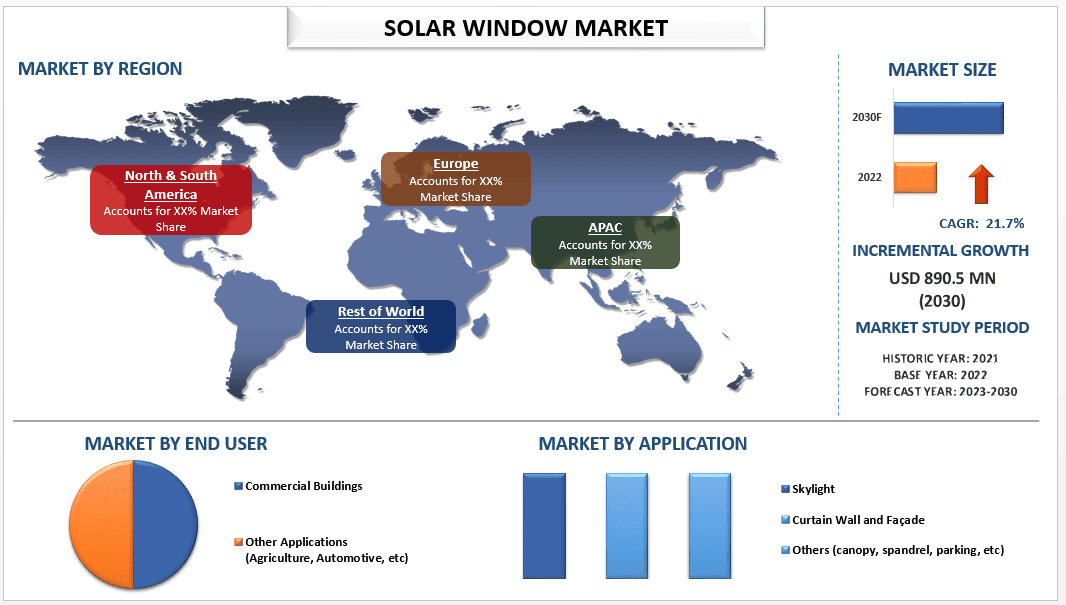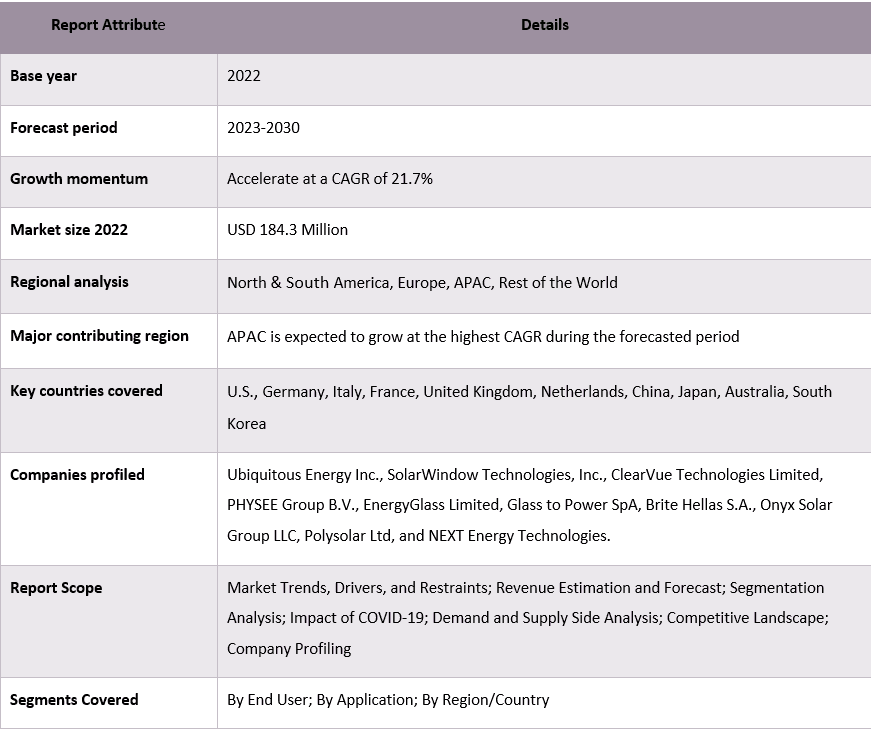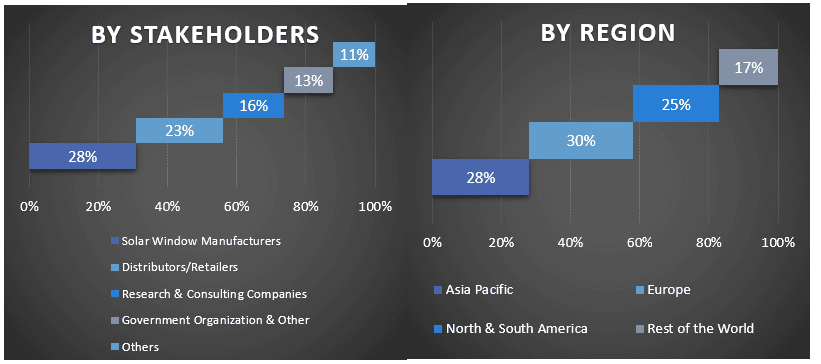- Home
- About Us
- Industry
- Services
- Reading
- Contact Us
Solar Window Market: Current Analysis and Forecast (2023-2030)
Emphasis on End User (Commercial Building, and Others (Agriculture, Automotive, etc.)); Application (Skylight, Curtain Wall and Façade, and Others (canopy, spandrel, parking, etc.)); and Region/Country

The Solar Window Market is expected to grow at a strong CAGR of 21.7% during the forecast period. It is mainly owing to the government programs and incentives to promote cleaner renewable energy in order to meet climate change policies globally. Although solar windows were in development for a long time, they were introduced a decade back to the public. Sharp Corporation introduced solar windows in 2012 at a press conference in Japan. The product received good news coverage but had very low solar energy efficiency. The company planned to launch the technology in Japan as a test market but hold its plans in order to increase its efficiency before officially launching the product.
Solar Windows can only be seen in commercial properties as it has not been launched for the residential sector. Even in the commercial segment, only some countries have access to solar windows. Most companies have not started producing the product commercially as the efficiency of the panel is still a huge hurdle many organizations have not been able to solve yet. However, huge organizations are incorporating new solar window technology in their buildings. For instance – Bell Works in Holmdel, NJ; Tanjong Pagar in Singapore; Edmonton Convention Center Atrium in Canada, National Energy Services Reunited Corp in Dammam, Saudi Arabia and Newark Liberty International Airport in New Jersey, United States.
Some of the major players operating in the market are Ubiquitous Energy Inc., SolarWindow Technologies, Inc., ClearVue Technologies Limited, PHYSEE Group B.V., EnergyGlass Limited, Glass to Power SpA, Brite Hellas S.A., Onyx Solar Group LLC, Polysolar Ltd, and NEXT Energy Technologies.
Several M&As along with partnerships have been undertaken by these players to facilitate customers with hi-tech and innovative products/technologies.
Insights Presented in the Report
“Amongst End User, the Commercial Buildings segment held a dominating share of the market in 2022”
- Based on End User, The Solar Window market is divided into Commercial Buildings and Others (Agriculture, Automotive, etc.) segments. The Commercial Buildings segment acquired a majority share in the Solar Window market and is expected to showcase a substantial growth rate during the forecast period. Solar PV remains the most competitive source of Renewable energy generation globally; however, building large-scale installations is becoming increasingly challenging in many regions of the world due to the lack of suitable sites. Moreover, Solar PV is the main choice for the private sector if they want to invest in renewable energy. Companies investing in distributed (including rooftop) solar PV installations on their commercial buildings and premises are responsible for around 30% of the total installed PV capacity, moreover, Companies are entering into corporate power purchase agreements with solar PV plant operators. The main target consumer of the solar window is big corporate buildings as solar window requires a large vertical area in order to generate the required energy solar windows have a very low solar-to-energy conversion rate. A day school in Denmark called Copenhagen International School, has installed 12,000 “hued but clear” solar panels.
“Amongst Applications, the curtain wall & Façade segment held a dominating share of the market in 2022”
Based on Application, the solar window market is segmented into skylight, curtain wall & Façade and Others segment. The solar windows can be applied to any part of the building but since the market is still in development stage, the main areas of application right now is skylight and curtain wall & Façade. Photovoltaic skylights not only generate free electricity, but also provide natural light, as well as UV and IR filter. Novartis Pharmaceutical’s HQ, the American Airlines Arena in Florida, and Bell Works in New Jersey are some of the companies which have incorporated solar window skylight in their companies. However, the most popular Segment would be Curtain Wall and Façade, these constitute the most surface area in a building where solar windows can be installed and are also the main target of solar window companies. USA (Culver City Creative Office Building designed by Gensler); Spain (GDR Headquarters and also Valdecilla Hospital); and Chile (Punta Arenas) are some of the buildings which have already incorporated solar windows in their buildings.
Solar Window Market Report Coverage

“APAC dominated the Solar Window market in 2022”
APAC registered the highest market share in the Solar Window market and is expected to witness an influential CAGR in the forecasted period. It is mainly owing to many Solar Window projects taking place in China, south korea, and Japan. Moreover, favorable government policies, regulations, and investments in achieving renewable energy targets set by various countries are driving the market. For instance: In Australia, the Australian government will provide AUD 14 million to support 5B’s AUD 33.4 million strategic technology innovation project through the Australian Renewable Energy Agency; In Japan, the Japanese government allocated 8 billion yen in the 2021 national budget to support the introduction of independent solar power generation equipment and storage batteries including electric vehicles through on-site PPA; and in India, the Government of India announced an additional capital infusion of Rs. 10 billion to the Solar Energy Corporation of India and Rs.15 billion to the Indian Renewable Energy Development Agency.
Reasons to buy this report:
- The study includes market sizing and forecasting analysis validated by authenticated key industry experts.
- The report presents a quick review of overall industry performance at one glance.
- The report covers an in-depth analysis of prominent industry peers with a primary focus on key business financials, product portfolios, expansion strategies, and recent developments.
- Detailed examination of drivers, restraints, key trends, and opportunities prevailing in the industry.
- The study comprehensively covers the market across different segments.
- Deep dive regional level analysis of the industry.
Customization Options:
The global Solar Window market can further be customized as per the requirement or any other market segment. Besides this, UMI understands that you may have your own business needs, hence feel free to connect with us to get a report that completely suits your requirements.
Table of Content
Research Methodology for the Solar Window Market Analysis (2023-2030)
Analyzing the historical market, estimating the current market, and forecasting the future market of the global Solar Window market were the three major steps undertaken to create and analyze the adoption of Solar windows in major regions globally. Exhaustive secondary research was conducted to collect the historical market numbers and estimate the current market size. Secondly, to validate these insights, numerous findings and assumptions were taken into consideration. Moreover, exhaustive primary interviews were also conducted, with industry experts across the value chain of the global Solar Window market. Post assumption and validation of market numbers through primary interviews, we employed a top-down/bottom-up approach to forecasting the complete market size. Thereafter, market breakdown and data triangulation methods were adopted to estimate and analyze the market size of segments and sub-segments of the industry pertains to. Detailed methodology is explained below:
Analysis of Historical Market Size
Step 1: In-Depth Study of Secondary Sources:
Detail secondary study was conducted to obtain the historical market size of the Solar Window market through company internal sources such as annual reports & financial statements, performance presentations, press releases, etc., and external sources including journals, news & articles, government publications, competitor publications, sector reports, third-party database, and other credible publications.
Step 2: Market Segmentation:
After obtaining the historical market size of the Solar Window market, we conducted a detailed secondary analysis to gather historical market insights and share for different segments & sub-segments for major regions. Major segments are included in the report as End User, and Application. Further country-level analyses were conducted to evaluate the overall adoption of testing models in that region.
Step 3: Factor Analysis:
After acquiring the historical market size of different segments and sub-segments, we conducted a detailed factor analysis to estimate the current market size of the Solar Window market. Further, we conducted factor analysis using dependent and independent variables such as End User, and Application of the Solar Window market. A thorough analysis was conducted for demand and supply-side scenarios considering top partnerships, mergers and acquisitions, business expansion, and product launches in the Solar Window market sector across the globe.
Current Market Size Estimate & Forecast
Current Market Sizing: Based on actionable insights from the above 3 steps, we arrived at the current market size, key players in the global Solar Window market, and market shares of the segments. All the required percentage shares split, and market breakdowns were determined using the above-mentioned secondary approach and were verified through primary interviews.
Estimation & Forecasting: For market estimation and forecast, weights were assigned to different factors including drivers & trends, restraints, and opportunities available for the stakeholders. After analyzing these factors, relevant forecasting techniques i.e., the top-down/bottom-up approach were applied to arrive at the market forecast for 2030 for different segments and sub-segments across the major markets globally. The research methodology adopted to estimate the market size encompasses:
- The industry’s market size, in terms of revenue (USD) and the adoption rate of the Solar Window market across the major markets domestically
- All percentage shares, splits, and breakdowns of market segments and sub-segments
- Key players in the global Solar Window market in terms of technology offered. Also, the growth strategies adopted by these players to compete in the fast-growing market
Market Size and Share Validation
Primary Research: In-depth interviews were conducted with the Key Opinion Leaders (KOLs) including Top Level Executives (CXO/VPs, Sales Head, Marketing Head, Operational Head, Regional Head, Country Head, etc.) across major regions. Primary research findings were then summarized, and statistical analysis was performed to prove the stated hypothesis. Inputs from primary research were consolidated with secondary findings, hence turning information into actionable insights.
Split of Primary Participants in Different Regions

Market Engineering
The data triangulation technique was employed to complete the overall market estimation and to arrive at precise statistical numbers for each segment and sub-segment of the global Solar Window market. data was split into several segments & sub-segments post studying various parameters and trends in the areas of End User, and Application in the global Solar Window market.
The main objective of the Global Solar Window Market Study
The current & future market trends of the global Solar Window market were pinpointed in the study. Investors can gain strategic insights to base their discretion for investments on the qualitative and quantitative analysis performed in the study. Current and future market trends determined the overall attractiveness of the market at a regional level, providing a platform for the industrial participant to exploit the untapped market to benefit from a first-mover advantage. Other quantitative goals of the studies include:
- Analyze the current and forecast market size of the Solar Window market in terms of value (USD). Also, analyze the current and forecast market size of different segments and sub-segments
- Segments in the study include areas of End User, and Application.
- Define and analysis of the regulatory framework for the Solar Window industry
- Analyze the value chain involved with the presence of various intermediaries, along with analyzing customer and competitor behaviors of the industry
- Analyze the current and forecast market size of the Solar Window market for the major regions
- Major countries of regions studied in the report include Asia Pacific, Europe, North & South America, and the Rest of the World
- Company profiles of the Solar Window market and the growth strategies adopted by the market players to sustain in the fast-growing market
- Deep dive regional level analysis of the industry
Related Reports
Customers who bought this item also bought










